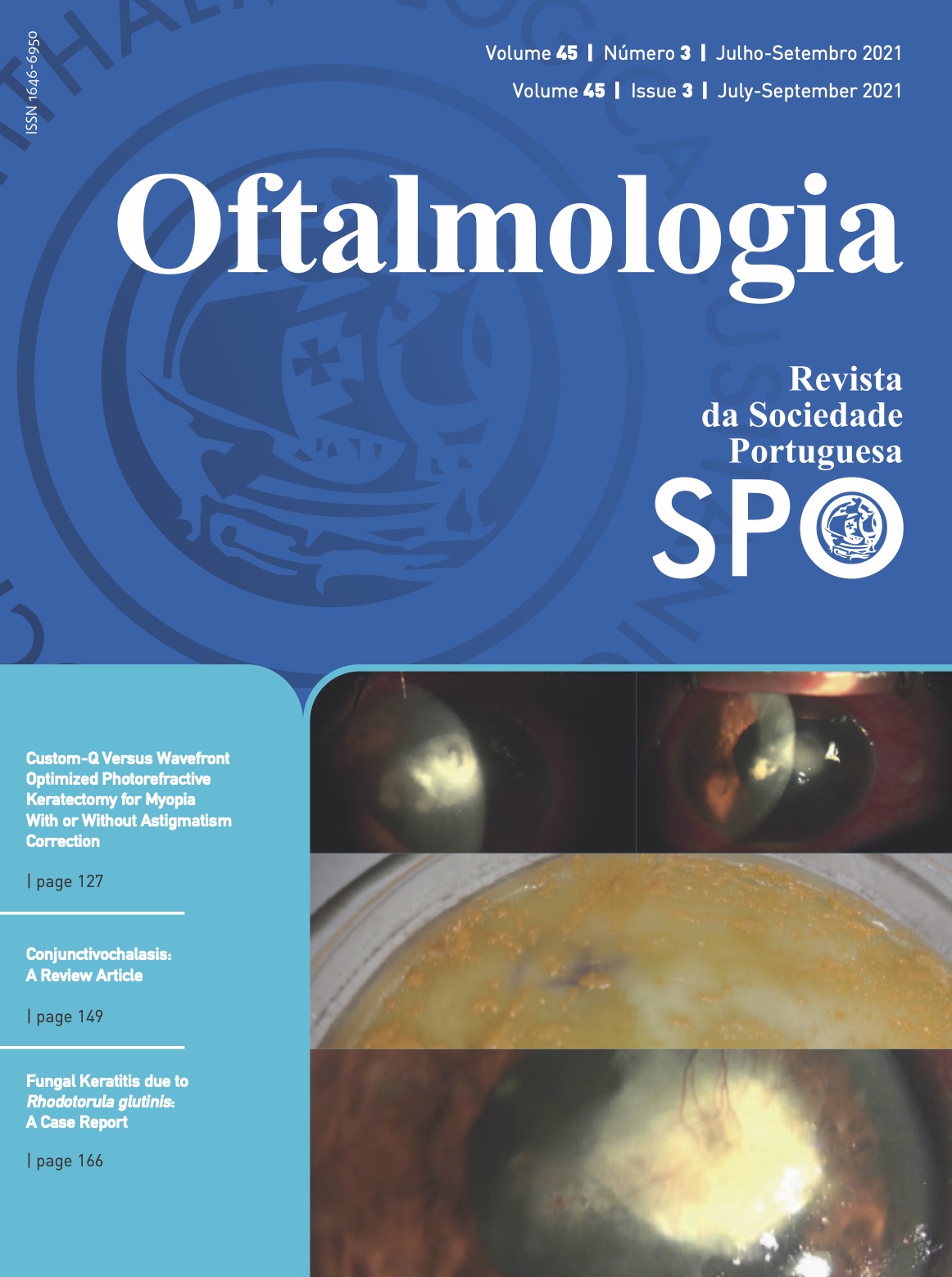Relationship of Objective Metrics for Quantifying Age-related Nuclear Cataracts with Visual Acuity and Phacodynamics
DOI:
https://doi.org/10.48560/rspo.25540Keywords:
Cataract, Lens Nucleus, Crystalline, Diagnostic Techniques, Ophthalmological, PhacoemulsificationAbstract
IntroductIon: An appropriate evaluation cataract degree is essential for deciding to proceed with surgery. Our purpose was to study the relationship between objective metrics for quantifying age-related nuclear cataracts with visual impairment and phacodynamics parameters.
Methods: Thirty eyes (30 patients) with age-related nuclear cataract were submitted to phacoemulsification. The average lens density (0 to 100) was evaluated by using a rotating Scheimpflug system (Pentacam HR, Oculus, Wetzlar, Germany) and the nuclear opalescence (NO) score was subjectively assessed using the Lens Opacities Classification System III (LOCS III). This different parameters were correlated with preoperative corrected distance visual acuity (CDVA) and cumulative dissipated energy (CDE).
Results: The preoperative CDVA was correlated with the Scheimpflug-measured lens nuclear density value (r=0.617, p<0.01). The CDE was posi-tively correlated with the Scheimpflug-derived average density variable (r=0.681 p<0.01) than with LOCS III NO (r=0.661, p<0.01).
Conclusion: The Scheimpflug-measured average density was correlated with subjective lens grading and preoperative CDVA. This metric also presented the highest positive correlation with phacodynamics.
Downloads
References
Chylack LT, Jr., Wolfe JK, Friend J, Khu PM, Singer DM, McCa- rthy D, et al. Quantitating cataract and nuclear brunescence, the Harvard and LOCS systems. Optom Vis Sci. 1993;70:886- 95. doi: 10.1097/00006324-199311000-00005.
Chylack LT, Wolfe JK, Singer DM, Leske MC, Bullimore MA, Bailey IL, et al. The Lens Opacities Classification System III. The Longitudinal Study of Cataract Study Group. Arch Ophthalmol. 1993;111:831-6. doi: 10.1001/archopht.1993.01090060119035.
Karbassi M, Khu PM, Singer DM, Chylack LT, Jr. Evaluation of lens opacities classification system III applied at the slit- lamp. Optom Vis Sci. 1993;70:923-8.
Datiles MB, Magno BV, Freidlin V. Study of nuclear cataract progres-sion using the National Eye Institute Scheimpflug system. Br J Ophthalmol. 1995;79:527-34.
Grewal DS, Brar GS, Grewal SP. Correlation of nuclear cata- ract lens density using Scheimpflug images with Lens Opaci- ties Classification System III and visual function. Ophthalmol- ogy. 2009;116:1436-43. doi: 10.1016/j.ophtha.2009.03.002.
Magalhães FP, Costa EF, Cariello AJ, Rodrigues EB, Hofling-Lima AL. Comparative analysis of the nuclear lens opales- cence by the Lens Opacities Classification System III with nuclear density values provided by Oculus Pentacam: a cross- section study using Pentacam Nucleus Staging software. Arq Bras Oftalmol. 2011;74:110-3.
Pei X, Bao Y, Chen Y, Li X. Correlation of lens density meas- ured using the Pentacam Scheimpflug system with the Lens Opacities Classification System III grading score and visual acuity in age-related nuclear cataract. Br J Ophthalmol. 2008;92:1471-5. doi: 10.1136/bjo.2007.136978.
Ullrich K, Pesudovs K. Comprehensive assessment of nuclear and cortical backscatter metrics derived from rotating Scheimpflug images. J Cataract Refract Surg. 2012;38:2100-7. doi: 10.1016/j.jcrs.2012.07.033.
Weiner X, Baumeister M, Kohnen T, Bühren J. Repeatability of lens densitometry using Scheimpflug imaging. J Cataract Refract Surg. 2014;40:756-63. doi: 10.1016/j.jcrs.2013.10.039.
Kirkwood BJ, Hendicott PL, Read SA, Pesudovs K. Repeatability and validity of lens densitometry measured with Scheimpflug imaging. J Cataract Refract Surg. 2009;35:1210-5
Faria-Correia F, Lopes BT, Ramos IC, Monteiro T, Franqueira N, Ambrosio R, Jr. Application of different Scheimpflug-based lens densitometry methods in phacodynamics prediction. Clin Ophthalmol. 2016;10:609-15. doi: 10.2147/OPTH.S95993.
Gupta M, Ram J, Jain A, Sukhija J, Chaudhary M. Correlation of nu-clear density using the Lens Opacity Classification System III versus Scheimpflug imaging with phacoemulsification parameters. J Cataract Refract Surg. 2013;39:1818-23. doi: 10.1016/j.jcrs.2013.05.052.
Kim JS, Chung SH, Joo CK. Clinical application of a Scheimpflug system for lens density measurements in phaco- emulsification. J Cataract Refract Surg. 2009;35:1204-9. doi: 10.1016/j.jcrs.2009.02.032.
Lim SA, Hwang J, Hwang KY, Chung SH. Objective assessment of nuclear cataract: comparison of double-pass andScheimpflug systems. J Cataract Refract Surg. 2014;40:716-21. doi: 10.1016/j.jcrs.2013.10.032.
Nixon DR. Preoperative cataract grading by Scheimpflug imaging and effect on operative fluidics and phacoemulsification energy. J Cataract Refract Surg. 2010;36:242-6. doi: 10.1016/j.jcrs.2009.08.032.
Faria-Correia F, Ramos I, Lopes B, Monteiro T, Franqueira N, Ambrosio R, Jr. Comparison of Dysfunctional Lens Index and Scheimpflug Lens Densitometry in the Evaluation of Age-Related Nuclear Cataracts. J Refract Surg. 2016;32:244-8. doi: 10.3928/1081597X-20160209-01.
Faria-Correia F, Lopes B, Monteiro T, Franqueira N, Ambrosio R, Jr. Scheimpflug lens densitometry and ocular wavefront aberrations in patients with mild nuclear cataract. J Cataract Refract Surg. 2016;42:405-11. doi: 10.1016/j.jcrs.2015.10.069.
Faria-Correia F, Ramos I, Lopes B, Monteiro T, Franqueira N, Ambrósio R Jr. Correlations of Objective Metrics for Quantifying Dysfunctional Lens Syndrome With Visual Acuity and Phacodynamics. J Refract Surg. 2017;33:79-83. doi: 10.3928/1081597X-20161206-05.
Downloads
Published
How to Cite
Issue
Section
License
Copyright (c) 2021 Revista Sociedade Portuguesa de Oftalmologia

This work is licensed under a Creative Commons Attribution-NonCommercial 4.0 International License.
Do not forget to download the Authorship responsibility statement/Authorization for Publication and Conflict of Interest.
The article can only be submitted with these two documents.
To obtain the Authorship responsibility statement/Authorization for Publication file, click here.
To obtain the Conflict of Interest file (ICMJE template), click here





